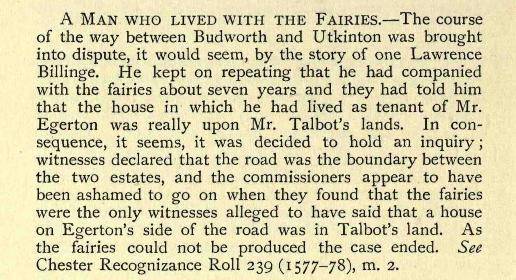The Man Who Lived with the Fairies? June 3, 2016
Author: Beach Combing | in : Modern , trackback
Here is a fairy reference that is worth spending some time over. In 1919 a northwestern English scholar published this short note. In academic terms it translates into, ‘look I don’t have time for this nonsense but somewhere out there someone will be interested and, God knows, this is out of the ordinary’. No one ever took the anonymous writer on the challenge so let’s relaunch his appeal:
A Man Who Lived with the Fairies. – The course of the way between Budworth and Utkinton was brought into dispute, it would seem, by the story of one Lawrence Billinge. He kept on repeating that he had companied with the fairies about seven years and they had told him that the house in which he had lived as tenant of Mr. Egerton was really upon Mr. Talbot’s lands. In consequence, it seems, it was decided to hold an inquiry; witnesses declared that the road was the boundary between the two estates, and the commissioners appear to have been ashamed to go on when they found that the fairies were the only witnesses alleged to have said that a house on Egerton’s side of the road was in Talbot’s land. As the fairies could not be produced the case ended. See Chester Recognizance Roll 239 (1577-78), m. 2.
Lawrence seems to have been a fairy-seer, a man who could (or alleged he could) communicate with the fairies. He used this reputation to claim that his true landlord was not the guy who turned up for rent. This is less curious though than the claim that he had ‘companied with the fairies about seven years’. ‘Companied’ is not a routine modern English word and so was probably taken over from the original Roll. The author of the note took ‘companied’ to mean that Lawrence had actually lived with the fairies: see the title. Perhaps it meant, rather, that he had ‘hung out’ with the same? Note the magical seven years: perhaps an apprenticeship – if you are sceptical there are other examples of seven years in this context. In any case, it is remarkable, first, that he claimed this and did not get in trouble from the local ecclesiastical court ( a hundred years later it would have been a different matter); and second that his claims sparked a legal inquiry in which witnesses were called to mark out the boundaries between the two territories.
Source: Transactions of the Historic Society of Cheshire and Lancashire 71 (1919), 92 and the CRR’s are at the National Archives. Can anyone help get them: drbeachcoming AT yahoo DOT com
Steven W., writes in, 31 Dec 2016, ‘I find the seven years fascinating. Time and time again in our sources fairymen and woman do seven years with the fairies. This is also true in Ireland. Interesting that the number is shared in both Britain (England and Wales) and Ireland. Is it just a magic number or is there something else?’


